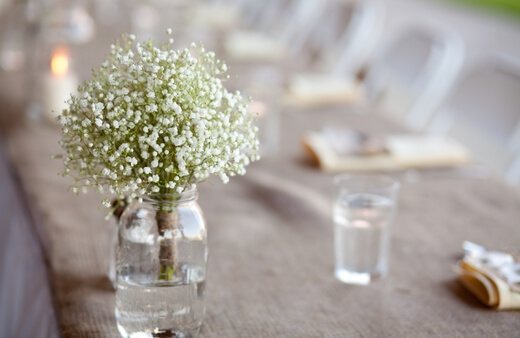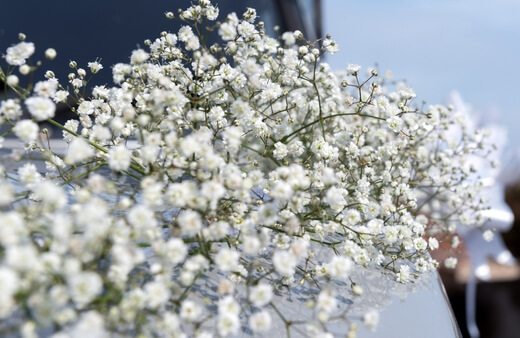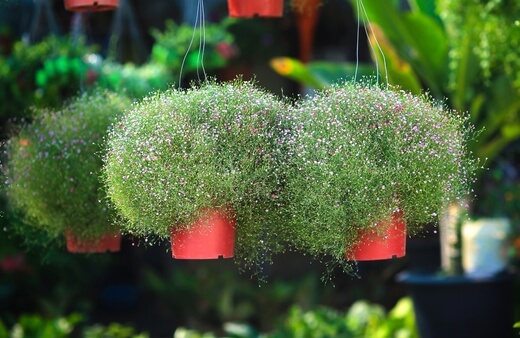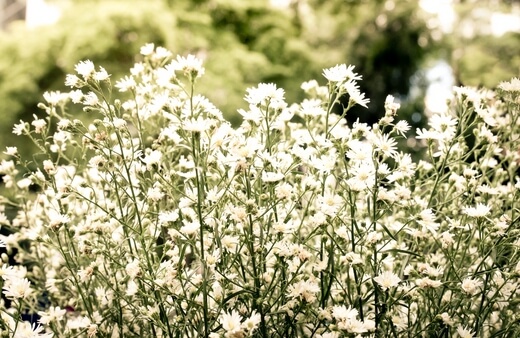Despite their delicate, frothy flowers, Baby's Breath are incredibly tough plants, and are able to withstand almost all Australian weather conditions, provided they are never in saturated, damp, cold, soil.
In this guide to growing gypsophila, we’ll look at some of the best reasons to grow them, as well as a few lesser known uses for these versatile plants.
More...

Family: | Caryophyllaceae |
|---|---|
Genus: | Gypsophila |
Species: | various |
Common Names: | Baby’s breath, Babe’s breath |
Location: | Outdoor |
Type: | Herbaceous perennial (some annual species) |
Growth: | 10x10cm to 50x50cm mounds |
Sun requirements: | Full sun, or bright partial shade |
Foliage Colour: | Green |
Flower Colour: | Pink or white |
Flowering: | Summer and Autumn |
Fruit: | None |
Maintenance level: | Low |
Poisonous for pets: | Mildly stomach irritating, but not deadly |
What is Baby's Breath?
Baby’s breath, perhaps better known by its botanical name ‘Gypsophila’, is a stunning perennial herbaceous plant that dies back completely each year, providing fresh green growth each spring, and plentiful flowers right through summer and into autumn with proper care.
The genus contains over 150 species, each with its own unique colouring, height and width, but they all share one common trait – mounding.
If you’re looking for a useful plant for rockeries, or to spill over and soften paths and lawn edges, gypsophila is one of the best plants for the job, and is low maintenance, as well as resilient against the occasional football being kicked at it.
The fleshy roots of baby’s breath are also a natural soap, rich in saponins, the organic compounds that provide natural soaps with their froth. While there are plants (like soapwort) with higher saponin content, it's worth remembering that your frothy herbaceous border filler is potentially a useful replacement for chemical soaps!

Natural Habitat of Gypsophila
Most species of gypsophila are native to Europe, Africa and Asia, having developed naturally across the connected continents. However, there are a handful of species that are native to Australia and the Pacific Islands which are very well suited to our garden conditions.
Their roots are tough, and able to cope with a variety of conditions, but they do appreciate the chance to move through clear seasonal change, from cold to wet, to dry.
In nature, baby’s breath spreads by seed and by root, creating swathes of frothy planting wherever it can take hold, in areas with full sun and reasonable but not excessive rainfall.
How to Grow Baby's Breath in Australia

Baby’s breath is really quite easy to grow at home, and the conditions below will work just as well in pots, containers and raised beds as they do in the ground.
Planting Baby's Breath Outdoors
Perennial baby's breath can be planted at any time of year provided the soil is warm enough (over 15°C), but the best time to plant roots and plants is early spring, giving them enough time to develop roots and establish before flowering in summer.
Soil
Prepare your soil for planting roots or potted baby’s breath by adding a good quality peat-free compost and digging it through the soil. If you have alkaline soil, or heavily acidic soil, amend the acidity with lime, sand, coffee grounds or other natural materials until you have a pH reading at 6-7pH (just slightly acidic).
Heavily clay soils will need amending with sand or grit, or avoided altogether by planting in pots filled with garden compost.
Spacing
Different species of baby’s breath have different spacing requirements, with some mounding to 10 cm across and tall, while others can reach 50 cm, and even 1 m across. Plant them accordingly to allow for some intermingling between plants, but not so close that they compete.


Get Your Free Guide:
Master Growing Australian Natives eBook
A Must Have Complete Guide for Every Australian Garden
Get Your Free Guide:
Master Growing Australian Natives eBook
A Must Have Complete Guide for Every Australian Garden
For an average gypsophila, like Pink Flamingo, which spreads to around 30 cm, plant them 25 cm apart, so that by summer you’ll have swathes of interconnected froth running through your beds.
Light
Gypsophila, or Baby's breath, requires good light conditions. That should ideally be full sun, with protection for the midday sun where possible, but any bright location will do, provided it gets 6 hours of direct light per day.
Water
Gypsophila have strong fleshy roots that are often mistaken for rhizomes. They store water well, so do not end watering as constantly as other ornamental perennials, but should not be allowed to dry out completely.
Aim to water gypsophila when the surface of the soil is dry, but there's still some moisture at a depth of 2”. This should avoid water logging and rotten roots, and provide a good balance of fresh water from spring to late autumn.
When the foliage begins to die back in late autumn, stop watering altogether until new growth emerges in spring.
How to Propagate Gypsophila
Baby’s breath can be propagated from cuttings, seed and roots, each as easily as the next. The main advantage of growing baby's breath from seed is cost saving, while growing from roots is utterly foolproof. Taking cuttings requires the right conditions, but once the cutting takes root, they are simple to care for, and don’t cost a penny.

Propagating Baby's Breath from Seeds
Choose a gypsophila cultivar that works well in your garden. Base that choice on colour, size, and growing conditions, rather than just visuals.
When you've got your seeds, ideally in late summer, prepare an open garden bed by raking in a few generous handfuls of compost and weeding out any unwanted plants.
Sprinkle gypsophila in well spaced rows (10-20 cm apart) and water well. There is no need to cover.
They should germinate in under two weeks in late summer, so keep an eye out for pests when they do. After that, thin the weakest seedlings out so you have plants spaced about 10-20 cm apart. In a warm, bright winter, they will grow right through into spring, in other cases, they will stall and flower the following summer.
Baby’s Breath Propagation from Cuttings
Gypsophila cuttings, like nearly all herbaceous perennials, are best taken in spring, from fresh growth. Cut as far down to the base of the plant as possible, removing a young stem at about 10-15 cm long, ideally keeping a small tail at the base of the cutting where it is attached to a main stem or root.
Plant the cutting into gritty compost, or a mix of 50% compost and 50% perlite. Water it well, and cover (with a plastic bag, or in a cold frame). After about 4 weeks, the cutting should be reasonably well-rooted, and can be moved out into the garden.
Propagating Baby’s Breath from Roots
Gypsophila roots are incredibly fleshy, and very effective water storage units for the plant above.
You can buy gypsophila as bare root plants in spring and early summer from most good garden retailers, and it will usually begin to grow as soon as the soil warms up in early spring onwards.
To take your own root cuttings from gypsophila, turn out a potted plant, and divide it in autumn as the foliage is dying back. Leave 2/3 of the plant in its original pot, and plant the remaining 1/3 into a new pot, ideally connected to at least one leading stem.
If you are expecting a cold, wet winter, hang the separated section upside down in a dry shed for a few days until the soil can be shaken off. Place it in a dry paper bag, out of any sunlight over winter, and then plant it straight into the garden in early spring.
How to Care for Baby’s Breath
Mature gypsophila, in their second or third year, really do benefit from mulching and feeding. They are perennial plants, but each plant is usually quite short lived, so feeding the roots will help them to develop new shoots, and send up their own new plants to save you from replacing them as regularly.

Mulching Baby’s Breath
Mulch baby’s breath in late winter or early spring. Depending on where you live, this should be before they begin growing. Avoid mulching over new growth, and if you’ve left it too late, just mulch around the base of the plant, leaving a few inches of bare soil for the plant to grow through.
The purpose of the mulch is to regulate soil temperature, conserve moisture, and fertiliser, so use a gentle mulch like leaf mould or peat-free compost. Manure can burn the delicate stems of gypsophila even after rotting down.
Check out our guide to know more about different types of mulches and learn how to use them.
Fertiliser
If mulching your garden or pots isn’t an option (often in raised beds, it's restricted by space and soil depth) add a granular fertiliser like chicken manure or any general purpose granular feed to the surface of the soil.
If you do this once in spring, there will be no need to repeat feed gypsophila through summer unless you have very, very, free draining soil, in which case, mulch is a better option as it will help to improve soil structure and moisture retention in the long run.
Pruning and Repotting Baby’s Breath
Some species of baby's breath have shorter flowering windows than others, often finishing in early summer, and leaving you with plenty of seed heads, but little flower for the rest of the season.
A harsh prune (1/3 of the plant) will trigger new growth, and if weather conditions are right, a second flush of flowers in early autumn.
Like any fleshy-rooted perennial, gypsophila will require regular repotting if grown in containers. Every two years at most. When leading stems are coming up within 2” of the edge of a pot, it's time to either find a bigger container, or divide your plants into two smaller containers.
Baby’s Breath Pests and Diseases
Gypsophila are rarely affected by pests, and their only common diseases are root rot and stem rot due to overwatering, or poor drainage. If you notice young stems being eaten, it's often slugs, and providing sacrificial plants nearby will usually deter them.
Nasturtiums are the most effective for this as slugs will devour them happily, and the plant will continue to grow, flowering with gorgeous fiery orange blooms through summer and into autumn, providing a perfect backdrop for the frothy whites of baby’s breath.
To avoid root rot, make sure your soil is well drained at the time of planting, and if you have automatic irrigation in the garden, set it to water 2” a week, and a touch more in summer, or divert it away from gypsophila.
Baby’s Breath Frequently Asked Questions

Is baby’s breath toxic?
Baby’s breath is mildly toxic to pets and humans, but will rarely cause side effects other than passing stomach upsets. Excessive consumption can lead to more severe side effects, but it is safe to grow in the garden.
Is baby’s breath good luck?
Baby’s breath has been used to symbolise hope, rebirth and new beginnings, and is given in wedding bouquets and at baby showers as a blessing, sharing well wishes and good fortune for the years ahead.
Can you use baby’s breath to make soap?
Baby’s breath flowers might be toxic, but by blitzing and soaking the roots in water you can extract a thick, suddy liquid that will work as a detergent soap for dishes, and even as a shampoo. Check it this Baby's breath soap tutorial and have fun making your own.
How long does baby’s breath last as a cut flower?
Baby’s breath usually lasts for 1-2 weeks in a vase. To extend its life, trim the base of the stem with sterilised scissors and add to water with a few drops of vinegar or bleach to prevent rotting, and retain rigidity in the stems.
When dried, baby’s breath provides a more structural element to bouquets than can last for months.
How long do baby’s breath roots last?
Baby’s breath roots last for several months if stored correctly in a cool, dry environment away from any light. Just like their roots in the ground, which prefer to be cool, dark and dry over winter during dormancy, roots can be stored for the same period of time out of the ground, provided they are kept dry.
How hard is it to grow baby’s breath?
A baby's breath is incredibly simple to grow, and flowers quickly after planting. For an easy border-filling plant, there are few simpler options than baby’s breath.
How do you grow baby’s breath indoors?
If you are unsure of your outdoor temperatures, or want to get a head start on spring, you can grow baby’s breath indoors from early winter, before planting out into the garden in early winter. Mature plants should be grown outdoors, and will suffer in indoor conditions.
Wrapping Up Our Baby's Breath Guide
Baby's breath goes in and out of fashion, but regardless of how you feel about keeping your garden up to date, it’s worth maintaining, as there is no plant that can adequately replace the gentle, cloudy froth of this stunning herbaceous border filler.
Perhaps the most useful thing about baby’s breath in any garden is that it provides an accurate gauge on your soil quality and moisture levels, with its need for neutral, moist, but not sodden soil.
If your baby’s breath is thriving, it’s a good indication that the rest of the garden is happy and healthy.
Published on March 10, 2023 by Maisie Blevins
Last Updated on February 23, 2025




